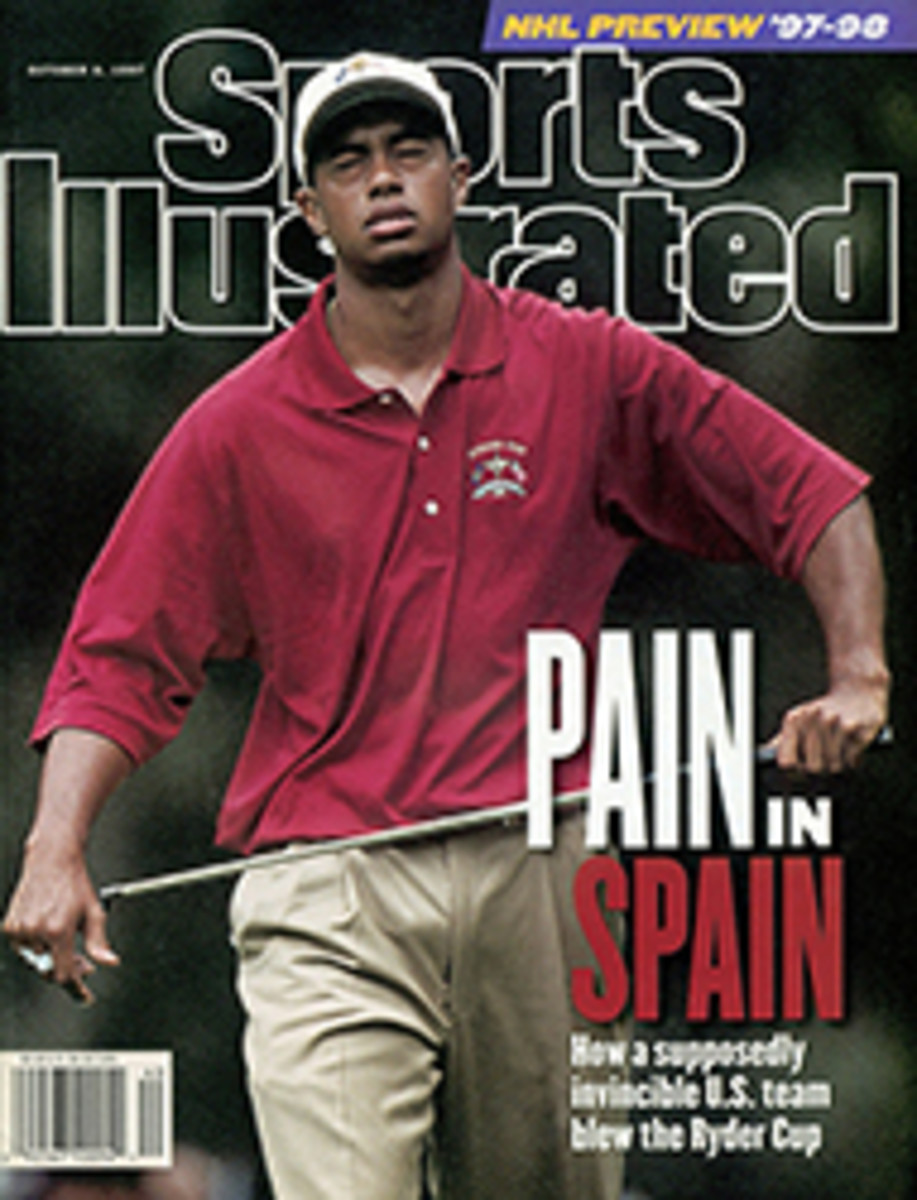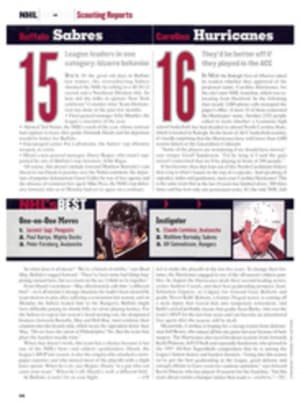
TOO FAST FOR COMFORT CART'S FIRST VISIT TO THE SUPER QUICK CALIFORNIA SPEEDWAY PRODUCED RECORD SPEEDS--AND SOME VERY NERVOUS DRIVERS
After turning the fastest qualifying lap in auto racing
history--240.942 mph last Saturday at the new California
Speedway outside Los Angeles--Mauricio Gugelmin didn't even
smile when he spoke to reporters afterward. He would rather have
won the pole for Sunday's Marlboro 500, the CART season finale,
without making history. "I guess breaking the 240 barrier is a
magic number, but everyone is a bit nervous," said Gugelmin, a
Brazilian who moved from Formula One to CART in 1993. "I think
nobody's comfortable. I'm not. I think sometimes we push the
laws of physics [too far]."
Gugelmin and two other drivers broke Arie Luyendyk's single-lap
qualifying record of 237.498, set at Indianapolis Motor Speedway
in '96. Eleven more drivers broke the CART record of 234.665,
set by Jimmy Vasser at Michigan Speedway last year.
Vasser, who qualified second at 239.222, agreed with Gugelmin,
saying, "A lot of bad things can happen at those speeds if
something on the car breaks." Vasser had seen one of those bad
things during practice last Friday, when his teammate, CART
season champion Alex Zanardi, spun his Reynard-Honda into the
wall at more than 230 mph. Zanardi, who had wrapped up the
series points championship at Laguna Seca on Sept. 7, escaped
with a mild concussion but was unable to drive on Sunday.
The race, won by England's Mark Blundell, didn't live up to its
high-speed prelude, though several drivers turned laps in the
mid-230s. Blundell's average speed was a paltry 166.575 mph, the
result of five caution flags that flew for 41 of the 250 laps.
Driver misgivings about high speeds were confirmed only once,
when rookie Arnd Meier spun in front of Luyendyk, who was
filling in for Zanardi. Flying into Turn 4, Luyendyk had no time
to react and slammed hard into Meier. The collision forced
Luyendyk into the wall and briefly knocked him unconscious. He,
too, suffered a mild concussion.
At a time when the trend in every major form of motor racing is
to reduce speed in the interest of safety, CART drivers found
themselves pushing the envelope during qualifying. "At anything
above 237," said veteran Bobby Rahal, "you're basically just
hanging on."
The high speeds were the result of two factors, the first of
which is the California Speedway layout. The track was
designed--with considerable input from racers--to accommodate
both the heavy Winston Cup cars and the lighter, much faster
Indy cars. NASCAR drivers like the gradual transition from the
track's straightaways to its 14-degree banked turns; it helps
them maintain their speed. But that smooth transition allows
Indy drivers to carry more speed into the turns than at other
tracks, speeds that make them uncomfortable.
The other reason for the fast lap times is the close competition
among CART manufacturers, including the makers of tires
(Firestone and Goodyear), engines (Ford Cosworth, Honda,
Mercedes-Benz and Toyota) and chassis (Lola, Penske, Reynard and
Swift). Improvement in engine performance has bumped horsepower
to near 900--rivaling the unrestricted Formula One engines of
the early '90s as the mightiest power plants ever seen in
traditional motor racing.
Trying to ward off the higher speeds such power brings, CART
mandated a cut in turbocharger boost before the 1997 season.
That helped slow the cars early on. At the two-mile Michigan
Speedway, whose design the California track mimics, Scott
Pruett's July pole speed was a mere 233.857 mph. "That just
shows you what has happened in the technological race in the
past couple of months," says team owner Roger Penske.
Next season CART will introduce electronic pop-off valves to
more precisely regulate boost, which should slow down the cars
somewhat. CART president Andrew Craig said on Sunday that plans
to downsize engines from the current 2.65 liters to 1.8 had been
tabled for at least two years because of the expense of such a
changeover. "For now, we're looking at everything from boost to
reduced aerodynamic downforce to tires," said Craig. "We'd like
to bring speeds under 230 mph."
Some slowdown. But that's open-wheel racing: No record speeds,
no worries.
CRAM SESSION
In motor racing's inner circle, there was no holier term than
"the Month of May," the protracted annual ritual of testing,
practicing and qualifying for the Indianapolis 500. It was
sacred not only to Indy car racers but also to their
counterparts in NASCAR and Formula One. Richard Petty made
regular pilgrimages to the Brickyard, and Junior Johnson
visited, too, though neither ever drove or entered cars in the
500. Jean-Marie Balestre, president of FISA, the worldwide
governing body of motor sports, stood in Indy's pits in 1991 and
conceded, "This is the greatest race in the world."
Beginning next year, however, there will be no Month of May as
we've known it. The time allotted to Indy 500 preparations will
be cut nearly in half--from 17 days of on-track preparation in
recent years to nine--by edict of Indianapolis Motor Speedway
president Tony George. In cutting the schedule, George has
admitted, however indirectly, that the 500 is no longer capable
of holding fan interest over the course of the month. And the
reason it can't is that the event has been gutted by the
two-year conflict between George's Indy Racing League (IRL) and
CART, the end of which is nowhere in sight.
But the cutback also comes in recognition of economic realities.
For decades, drivers and team owners have grumbled that the long
encampment in Indianapolis was too expensive. Whacking the
schedule should help reduce costs, which was one of George's
stated aims when he created the IRL.
Still it seems odd that the move has come from George, the same
man who wrote a 2,000-word editorial in the Oct. 22, 1995,
Indianapolis Star, reasserting the sanctity of the Month of May.
In an open letter to the city, he claimed that CART teams, who
before the split had urged him to reduce the May schedule,
"would prefer to emasculate the Month of May.... I would be
ashamed if we let that happen here. It would be an incalculable
loss for both the world of racing and the local community." Now,
just when tradition is about all the 500 has left to sell,
George downsizes the event.
Tradition may not be the only casualty of the shorter schedule.
With most of the top drivers aligned with CART, the 500 field is
now filled with inexperienced and marginally qualified
drivers--13 of the 35 who started the '97 race were rookies--who
need all the practice running through the Brickyard's tricky
corners and down the fast straightaways they can get.
Nevertheless, George says he wants to "restore the intensity" of
the buildup to the 500. By cutting in half the Month of May, in
all its anachronistic magnificence, you may look only half as
bad, but you won't restore intensity. You just turn it into
another race week in the Midwest.
COLOR PHOTO: GEORGE TIEDEMANN After breaking the 240-mph barrier in qualifying, Gugelmin was fourth in a slow race. [Mauricio Gugelmin in race]
COLOR PHOTO: LOUISE NOETH Part car, part plane, Green's Thrust SSC streaked past the 700-mph mark. [Andy Green's car raising plume of dust in desert]
2.998
The number of additional miles traveled by the right wheels as
compared with the left wheels on the Winston Cup cars that
completed the 263-mile Hanes 500 at Martinsville (Va.) Speedway
on Monday. Of course, if the race had been run clockwise, the
left wheels would have logged the extra miles.
FAST FACTS
When England's Andy Green set a world land speed record of 714.1
mph last week at Black Rock Desert in Nevada, he became the
first person to break the 700-mph barrier without flying. In the
99 years since the first land speed record of 39.2 mph was set,
century barriers (100 mph, 200 mph, etc.) were sometimes knocked
off within a matter of months. But in the 32 years since Craig
Breedlove first hurtled past the 600-mph barrier in 1965, the
record had progressed to only 633.5, a mark set in 1984. Here
are the land speed records that broke each century mark:
Driver Year SPEED
Louis Rigolly 1904 103.6
Henry Segrave 1927 203.8
Malcolm Campbell 1935 301.1
Craig Breedlove 1963 407.5
Craig Breedlove 1964 526.3
Craig Breedlove 1965 600.6
Andy Green 1997 714.1
Stay on the inside track with Ed Hinton at www.cnnsi.com

